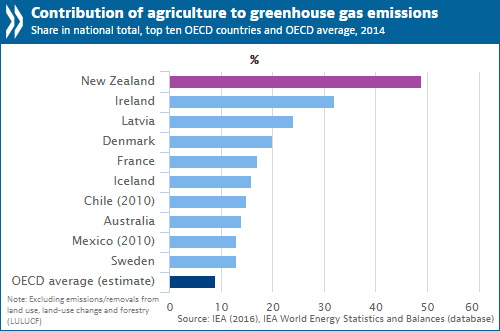Environmental pressures rising in New Zealand
New Zealanders enjoy a high environmental quality of life and access to pristine wilderness. However, New Zealand’s growth model, based largely on exploiting natural resources, is starting to show its environmental limits with increasing greenhouse gas emissions and water pollution, according to a new OECD report.

While the country only accounts for a tiny share of global emissions, the OECD’s third Environmental Performance Review of New Zealand finds that intensive dairy farming, road transport and industry have pushed up gross GHG emissions by 23% since 1990. Despite generating 80% of its electricity from renewable sources, among the highest in OECD countries, New Zealand has the second-highest level of emissions per GDP unit in the OECD and the fifth-highest emissions per capita.
“Having largely decarbonised its power generation, New Zealand needs to ensure its climate policies are effective in curbing emissions in all sectors, notably transport and agriculture,” said OECD Environment Director Simon Upton, presenting the report in Wellington. “This means strengthening the Emissions Trading Scheme and ensuring sectoral policies are aligned with the need for a low emissions transition.”
With respect to agriculture which accounts for 49% of emissions – the highest share in the OECD – the report suggests either incorporating emissions from agriculture into the Emissions Trading Scheme, or developing alternative measures to counter the pressures of farming. The use of environmentally related taxes, charges and prices should be expanded.
Growth in intensive dairy production has increased the level of nitrogen in soil, surface water and groundwater. The nitrogen balance (the difference between nutrients entering and leaving the system) increased more than in any other OECD country from 2000 to 2010.
Aware of the need to safeguard water quality, New Zealand has begun a process of freshwater policy reforms with a Clean Water Package of proposals in February that address some of the OECD recommendations. Further government support is needed to assist local authorities with setting rigorous goals and to speed up implementation.
The review also looks at New Zealand’s fast-growing cities and suggests that a simpler urban planning system, less restrictive land-use regulations and better co-ordination between land, transport and infrastructure planning could help ease the pressure. Car ownership in cities is high and many vehicles are old and emission-intensive. Current vehicle standards and taxes do not sufficiently encourage a shift towards cleaner, more efficient technologies.
Other recommendations include:
● Develop a long-term vision for a transition towards a low-carbon, greener economy
● Strengthen national-level management of air and water pollution and hazardous waste with more guidance and support to local authorities
● Accelerate implementation of water management reforms and ensure water quantity and quality limits are sufficiently ambitious. Expand the use of economic instruments to encourage more efficient water use and reduce pollution
● Build capacity of Maori communities to ensure their adequate participation in natural resource management planning
Source: Organization for Economic Co-operation and Development
- 346 reads
Human Rights
Fostering a More Humane World: The 28th Eurasian Economic Summi

Conscience, Hope, and Action: Keys to Global Peace and Sustainability

Ringing FOWPAL’s Peace Bell for the World:Nobel Peace Prize Laureates’ Visions and Actions

Protecting the World’s Cultural Diversity for a Sustainable Future

Puppet Show I International Friendship Day 2020

